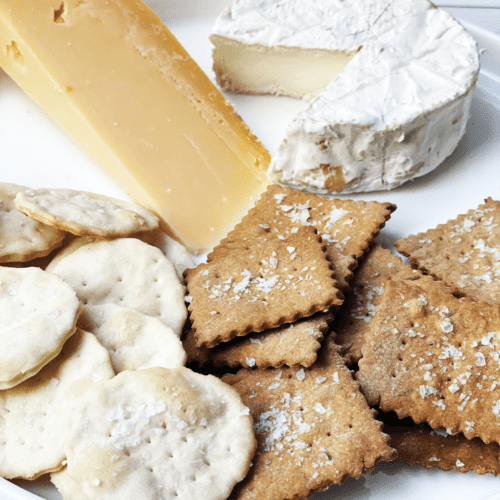Crackers seem like a timeless cheese tray accessory. But since historians say cheese has been made since 8000 B.C. and crackers only date back to 1792, it’s a relatively new match. Looking to make a shelf-stable food for sailors, entrepreneur John Pearson of Newburyport, Massachusetts, combined a lot of flour with a little water and baked the mixture until it was hard. He sold his inexpensive, non-perishable product as “Pearson’s Pilot Bread.” As it became a staple on most sea-faring vessels, it was colloquially called sea biscuit or hardtack.
Josiah Bent, another enterprising Massachusetts baker, also a retired sea captain, coined the term “cracker” circa 1800 when he left his biscuits in a brick oven until they burned and produced a crackling sound. Bent built a business on supplying hardtack to the Union troops fighting in the Civil War. He went on to sell his cracker business to the entity that became Nabisco, whose current parent company, Mondel z International (formerly Kraft), is a major player in the $21 billion worldwide biscuit and cracker market.
But you don’t have to buy into all of that. If you’ve got 30 minutes and basic ingredients in your kitchen—flour, water, oil, and salt—you can make your own crackers. Once you get the hang of it and the habit of making crackers into your routine, your recipe can evolve to include anything from heritage grain flours and flavorful liquids like buttermilk to any kind of seeded topping that strikes your fancy.
In The Cracker Book (Burford Books, 2012), author Lee E. Cart says the key to making crackers successfully lies in keeping basic ingredient ratios constant. You need 11⁄4 cups flour, 4 tablespoons water, 2 tablespoons oil, and 1⁄2 teaspoon salt to make a soft, pliable dough. Cart recommends rolling the dough to an 1⁄8-inch thickness for the crispiest crackers, but if you want them thicker, simply adjust the baking time accordingly. Regardless of their thickness, all crackers must be docked several times with the tines of a fork. Failing to do so will results in crackers with tops bloated by air bubbles.
Cart says that, like commercial crackers, homemade ones need to be stored in airtight containers. She suggests labeling those containers clearly—once you start making your own crackers, you’ll be hooked and storing several varieties at once.

Buttermilk and Rye Crackers
Ingredients
- 1 cup rye flour plus more for rolling
- 1/4 cup all-purpose flour
- 1/2 tsp table salt
- 4 tbsp buttermilk
- 2 tbsp olive oil plus more for brushing
- 1 tsp molasses
- 2 tbsp flaky sea salt
Instructions
- Combine flours and salt in the bowl of a stand mixer. Add buttermilk, oil, and molasses all at once and mix on low speed until the dough comes together, about 1 minute. Add caraway seeds and mix for 1 minute more. On a well-floured surface, roll dough out to 1⁄8-inch thickness. Use a sharp knife or a pizza cutter to cut 2-inch squares, about 30 crackers. Use tines of a fork to prick each cracker 3 times.
- Transfer cut crackers to unlined baking sheets. Brush tops with olive oil and sprinkle with flaky sea salt. Bake crackers for 12 to 15 minutes or until golden brown. Rotate pans midway through to ensure even baking. Cool crackers on a wire rack before storing them in an airtight container for up to a week.
Notes
- Blue cornmeal + red chili pepper flakes
- Balsamic vinegar + brown rice flour
- Almond meal + almond milk
- Dried cranberries + graham flour
- Maple + sage




